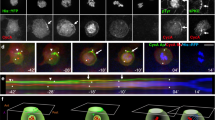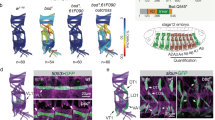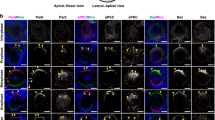Abstract
Asymmetric cell divisions can be mediated by the preferential segregation of cell-fate determinants into one of two sibling daughters. In Drosophila neural progenitors, Inscuteable1,2,3, Partner of Inscuteable4,5 and Bazooka6,7 localize as an apical cortical complex at interphase, which directs the apical–basal orientation of the mitotic spindle as well as the basal/cortical localization of the cell-fate determinants Numb8,9 and/or Prospero10,11 during mitosis. Although localization of these proteins shows dependence on the cell cycle, the involvement of cell-cycle components in asymmetric divisions has not been demonstrated. Here we show that neural progenitor asymmetric divisions require the cell-cycle regulator cdc2. By attenuating Drosophila cdc2 function without blocking mitosis, normally asymmetric progenitor divisions become defective, failing to correctly localize asymmetric components during mitosis and/or to resolve distinct sibling fates. cdc2 is not necessary for initiating apical complex formation during interphase; however, maintaining the asymmetric localization of the apical components during mitosis requires Cdc2/B-type cyclin complexes. Our findings link cdc2 with asymmetric divisions, and explain why the asymmetric localization of molecules like Inscuteable show cell-cycle dependence.
This is a preview of subscription content, access via your institution
Access options
Subscribe to this journal
Receive 51 print issues and online access
$199.00 per year
only $3.90 per issue
Buy this article
- Purchase on Springer Link
- Instant access to full article PDF
Prices may be subject to local taxes which are calculated during checkout




Similar content being viewed by others
References
Kraut, R. & Campos-Ortega, J. A. inscuteable, a neural precursor gene of Drosophila, encodes a candidate for a cytoskeleton adaptor protein. Dev. Biol. 174, 65–81 (1996).
Kraut, R., Chia, W., Jan, L. Y., Jan, Y. N. & Knoblich, J. A. Role of inscuteable in orienting asymmetric cell divisions in Drosophila. Nature 383, 50–55 (1996).
Li, P., Yang, X., Wasser, M., Cai, Y. & Chia, W. Inscuteable and Staufen mediate asymmetric localization and segregation of prospero RNA during Drosophila neuroblast cell divisions. Cell 90, 437–447 (1997).
Yu, F., Morin, X., Cai, Y., Yang, X. & Chia, W. Analysis of partner of inscuteable, a novel player of Drosophila asymmetric divisions, reveals two distinct steps in Inscuteable apical localization. Cell 100, 399–409 (2000).
Schaefer, M., Shevchenko, A., Shevchenko, A. & Knoblich, J. A. A protein complex containing Inscuteable and the Gα-binding protein Pins orients asymmetric cell divisions in Drosophila. Curr. Biol. 10, 353–362 (2000).
Wodarz, A., Ramrath, A., Kuchinke, U. & Knust, E. Bazooka provides an apical cue for Inscuteable localization in Drosophila neuroblasts. Nature 402, 544–547 (1999).
Schober, M., Schaefer, M. & Knoblich, J. Bazooka recruits Inscuteable to orient asymmetric cell divisions in Drosophila neuroblasts. Nature 402, 548–551 (1999).
Rhyu, M. S., Jan, L. Y. & Jan, Y. N. Asymmetric distribution of Numb protein during division of the sensory organ precursor cell confers distinct fates to daughter cells. Cell 76, 477–491 (1994).
Knoblich, J. A., Jan, L. Y. & Jan, Y. N. Asymmetric segregation of Numb and Prospero during cell division. Nature 377, 624–627 (1995).
Hirata, J., Nakagoshi, H., Nabeshima, Y. & Matsuzaki, F. Asymmetric segregation of the homeodomain protein Prospero during Drosophila development. Nature 377, 627–630 (1995).
Spana, E. & Doe, C. Q. The Prospero transcription factor is asymmetrically localised to the cell cortex during neuroblast mitosis in Drosophila. Development 121, 3187–3195 (1995).
Edgar, B. A. & O'Farrell, P. H. The three postblastoderm cell cycles of Drosophila embryogenesis are regulated in G2 by string. Cell 62, 469–480 (1990).
Edgar, B. A., Sprenger, F., Duronio, R. J., Leopold, P. & O'Farrell, P. H. Distinct molecular mechanisms regulate cell cycle timing at successive stages of Drosophila embryogenesis. Genes Dev. 8, 440–452 (1994).
Clegg, N. J., Whitehead, I. P., Williams, J. A., Spiegelman G. B. & Grigliatti, T. A. A developmental and molecular analysis of cdc2 mutations in Drosophila melanogaster. Genome 36, 676–685 (1993).
Stern, B., Ried, G., Clegg, N. J., Grigliatti, T. A. & Lehner, C. F. Genetic analysis of the Drosophila cdc2 homolog. Development 117, 219–232 (1993).
Doe, C. Q. Molecular markers for identified neuroblasts and ganglion mother cells in the Drosophila central nervous system. Development 116, 855–863 (1992).
Buescher, M. et al. Binary sibling neuronal cell fate decisions in the Drosophila embryonic central nervous system are nonstochastic and require inscuteable-mediated asymmetry of ganglion mother cells. Genes Dev. 12, 1858–1870 (1998).
Lear, B. C., Skeath, J. B. & Patel, N. H. Neural cell fate in rca1 and cycA mutants: the roles of intrinsic and extrinsic factors in asymmetric division in the Drosophila central nervous system. Mech. Dev. 88, 207–219 (1999).
Carmena, A., Murugasu-Oei, B., Menon, D., Jimenez, F. & Chia, W. inscuteable and numb mediate asymmetric muscle progenitor cell divisions during Drosophila myogenesis. Genes Dev. 12, 304–315 (1998).
Lu, B., Rothenberg, M., Jan, L. Y. & Jan, Y. N. Partner of Numb colocalises with Numb during mitosis and directs Numb asymmetric localisation in Drosophila neural and muscle progenitors. Cell 95, 225–235 (1998).
Shen, C. P., Jan, L. Y. & Jan, Y. N. Miranda is required for the asymmetric localisation of Prospero during mitosis in Drosophila. Cell 90, 449–458 (1997).
Ikeshima-Kataoka, H., Skeath, J. B., Nabeshima, Y., Doe, C. Q. & Matsuzaki, F. Miranda directs Prospero to a daughter cell during Drosophila asymmetric divisions. Nature 390, 625–629 (1997).
Schuldt, A. J. et al. Miranda mediates asymmetric protein and RNA localisation in the developing nervous system. Genes Dev. 12, 1847–1857 (1998).
Sigrist, S., Ried, G. & Lehner, C. F. Dmcdc2 kinase is required for both meiotic divisions during Drosophila spermatogenesis and is activated by the Twine/Cdc25 phosphatase. Mech. Dev. 53, 247–260 (1995).
Brand, A. H. & Perrimon, N. Targeted gene expression as a means of altering cell fates and generating dominant phenotypes. Development 118, 401–415 (1993).
Ducommun, B. et al. cdc2 phosphorylation is required for its interaction with cyclin. EMBO J. 10, 3311–3319 (1991).
Sigrist, S., Jacobs, H., Stratmann, R. & Lehner, C. F. Exit from mitosis is regulated by Drosophila fizzy and the sequencial destruction of cyclins A, B and B3. EMBO J. 14, 4827–4838 (1995).
Tio, M., Zavortink, M., Yang, X. & Chia, W. A functional analysis of inscuteable and its roles during Drosophila asymmetric cell divisions. J. Cell Sci. 112, 1541–1551 (1999).
Knoblich, J. A., Jan, L. Y. & Jan, Y. N. Deletion analysis of the Drosophila Inscuteable protein reveals domains for cortical localization and asymmetric localization. Curr. Biol. 9, 155–158 (1999).
Lundell, M. J. & Hirsh, J. A new visible light DNA fluorochrome for confocal microscopy. Biotechniques 16, 434–440 (1994).
Acknowledgements
We thank C. Q. Doe, M. Frasch, D. Glover, M. Harrington, Y.-N. Jan, E. Knust, Z. Lai, K. Matthews, F. Matsuzaki, P. O'Farrell, R. Saint, K. Zinn, the Developmental Studies Hybridoma Bank, Bloomington and Umea Stock Centres, and C. Lehner in particular for stocks and antibodies; F. S. Hing and C. T. Ong for technical support; M. Zavortink, U. Surana and members of our laboratory for comments and discussions; and IMCB for financial support. G.U. is supported by the Wellcome Trust.
Author information
Authors and Affiliations
Corresponding author
Rights and permissions
About this article
Cite this article
Tio, M., Udolph, G., Yang, X. et al. cdc2 links the Drosophila cell cycle and asymmetric division machineries. Nature 409, 1063–1067 (2001). https://doi.org/10.1038/35059124
Received:
Accepted:
Issue Date:
DOI: https://doi.org/10.1038/35059124
This article is cited by
-
Spatio-temporally separated cortical flows and spindle geometry establish physical asymmetry in fly neural stem cells
Nature Communications (2017)
-
Molecular mechanisms controlling asymmetric and symmetric self-renewal of cancer stem cells
Journal of Analytical Science and Technology (2015)
-
Asymmetric cell division in land plants and algae: the driving force for differentiation
Nature Reviews Molecular Cell Biology (2011)
-
Drosophila asymmetric division, polarity and cancer
Oncogene (2008)
-
The ins and outs of the plant cell cycle
Nature Reviews Molecular Cell Biology (2007)
Comments
By submitting a comment you agree to abide by our Terms and Community Guidelines. If you find something abusive or that does not comply with our terms or guidelines please flag it as inappropriate.



